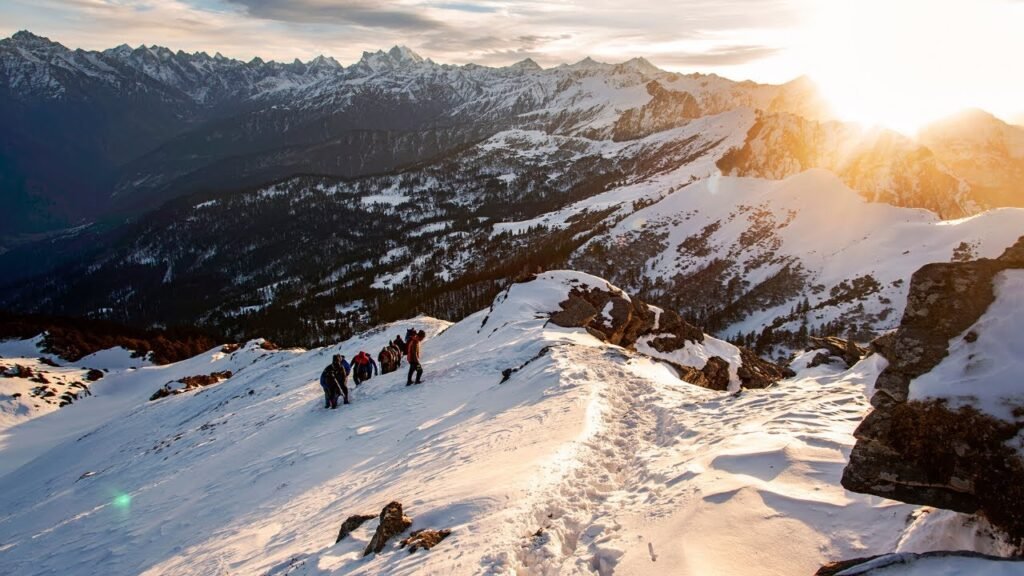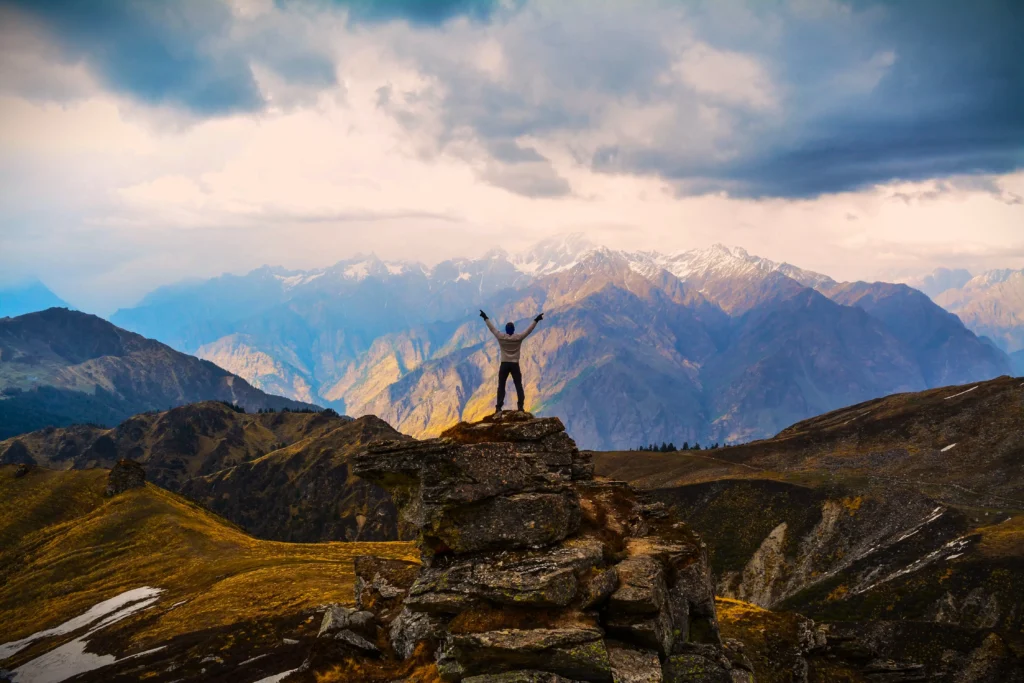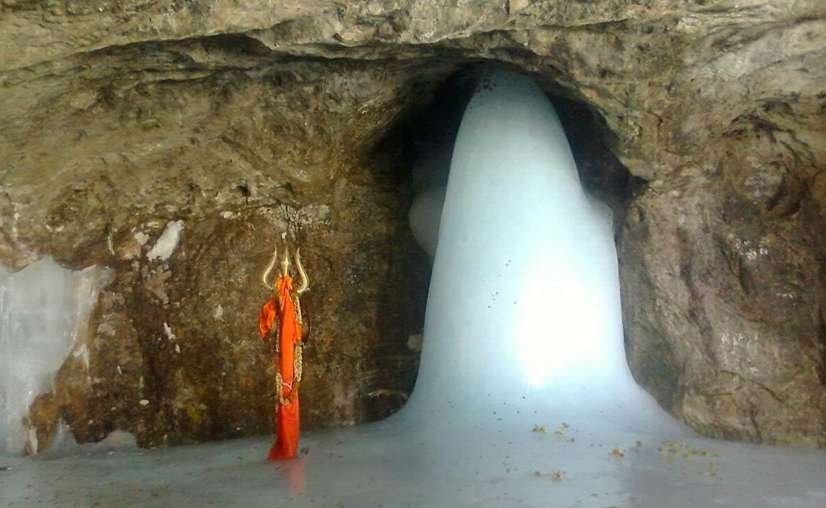
The Himalayas are a painting of majestic peaks and ancient spiritual energy, but few journeys have the respect and genuine adventure of the Gaumukh Tapovan trek. It’s an even more than a trail; it is a pilgrimage to the source of India’s lifeline, the holy River Ganga and a climb up to an other-worldly meadow where mountains rise like gods.
And picture standing at the point where the mighty river first pours from the belly of a huge glacier, icy cold and pristine. Now look up to the natural amphitheater, surrounded by God’s own ice-brush strokes and framed by the knockout spire of Mount Shivling…it feels like you’re sitting in on your very own audience with the gods. This the magic of the Gaumukh glacier trek and further up to the serene high alpine surrounding at Tapovan. Nestled amidst the mighty cragginess of Uttarakhand within the Gangotri National Park, this is a serene fusion of spiritual awakening, sheer adventure and unequalled beauty. It appeals to both the faithful pilgrim and grizzled trekker, a journey that purifies the soul and challenges it.
About Gaumukh Tapovan Trek
The hike to Tapovan is a classic Himalayan journey, beginning in the historic town of Gangotri and quickly climbing into upper-elevation wild lands.
Location and Geography
The entire route is within protected forest and the new ecofriendly huts wherever constructed fall in line with existing norms for shelters in upper reaches of a national park. The first day’s hike is along the noisy Bhagirathi River as it flows upstream. The starting point of the trek, Gangotri, is one among the four Chota Char Dham pilgrimage sites, so right at the start we’re given an early spiritual dose.
Height and Altitude Challenge
The trek ends at Tapovan, located at a stunningly difficult altitude of about 14,640 feet (4,463 meters). The trip to Gaumukh, the snout of the Gangotri Glacier, climbs to some 13,450 feet (4,100 meters). The substantial gain in altitude, as well as undulating and occasionally steep terrain requires good acclimatization and a high level of physical fitness.
Importance: Gaumukh as the Source
Gaumukh (Cow’s Mouth), the source of holy Bhagirathi River is its cheesecolored shared and madly shapes this notorious snout. It is considered to be the mythological and geographical source of the Bhagirathi River, the main tributary of Ganga (Ganges). The journey then takes you to Tapovan, a huge open meadow at the top of the glacier. Tapovan, or the ‘forest of penance’ is very popular as a spot for meditation by sadhus (Hindu ascetics) and it has some of the most stunning, unhindered views of the peaks around.
Highlights of the Gaumukh Tapovan Trek
The Gaumukh Tapovan trek is a treat to eyes and soul, a mere appearance of few Himalayan sights in the gallery.
The Sacred Snout of Gaumukh
Even the process of arriving at Gaumukh is an emotional journey. The snout of the glacier is a wonder to see – it’s always moving and changing. Seeing the baby river punch its way through the ice cave – one that has supported civilisations for thousands of years, is an eye-opening and spiritual experience that makes this a happening Gaumukh glacier trek.
Tapovan Meadows & Mt. Shivling
The real prize at the top of the punishing climb is Tapovan. In this tranquil meadow, with the mightiest of the Garhwal Himalayas forming its ring, you want to kiss the ground. Mt. Shivling (21,467 ft / 6,543 m) from Tapovan This is practically the most photographed mountain face in all of world Himalayan trekking! Its pristine and evenly-bared pyramid peak, popularly known as the ‘Matterhorn of India’ commands the skyline. Its neighbors, the towering group of the three sisters Bhagirathi (I, II and III), and Sudarshan Parbat are equally impressive and together they form a sight that would leave you awestruck. The view of the dawn breaking over Mt. Shivling is a sight to behold,words cannot do justice to this sight.
Adventure of Glacier Trekking
The last stretch from Bhojwasa to Tapovan is over the Gangotri Glacier itself. This part is nitty gritty and exciting. Care must be taken to negotiate the moraine, which consists of loose boulders and stones left behind from the glacier. This is what really takes the whole trip from being a walk to epic high altitude mountaineering.
Mix of Spirituality, Culture And Adventure
What sets this trek apart is how it mixes varied experiences so seamlessly. One minute, you are passing through saffron-clad sadhus singing in the trail; the next, you’re making your way up difficult ice formations with your heart pounding: The altitude suddenly reminded us of its power. This continual dynamic of the holy and untamed wilderness is characteristic of the trek.
Best Time to Visit and Weather Your trip can easily planned anytime through out the year.
The timing for your trek is also one of the essentials which would determine the panoramic views and a comfortable experience on Tapovan trek.
The Trekking Windows
Gaumukh Tapovan trek is generally available in two seasons:
Summer (May to June): This is the pre-monsoon time. Weather generally clears but the trail is snow free providing delightful walking. The river is running high, and the meadows are coming alive with early season flowers.
Autumn (September to October): Probably the best time for trek. Once the monsoon dissipates, the skies are scrubbed, providing spectacularly razor-sharp mountain views. Air is cool, and atmosphere is calm. It is the time of the grandest mountain vistas.
When to Avoid the Gaumukh Tapovan Trek
Monsoon (END JUNE TO AUGUST): Heavy rains lead to landslides, slippery paths and swollen streams, making the hike risky.
Winter (November – April): Trail is unaccessible due to heavy snow. The camps are snowed in and the area becomes icy and perilous for regular trekking trips.
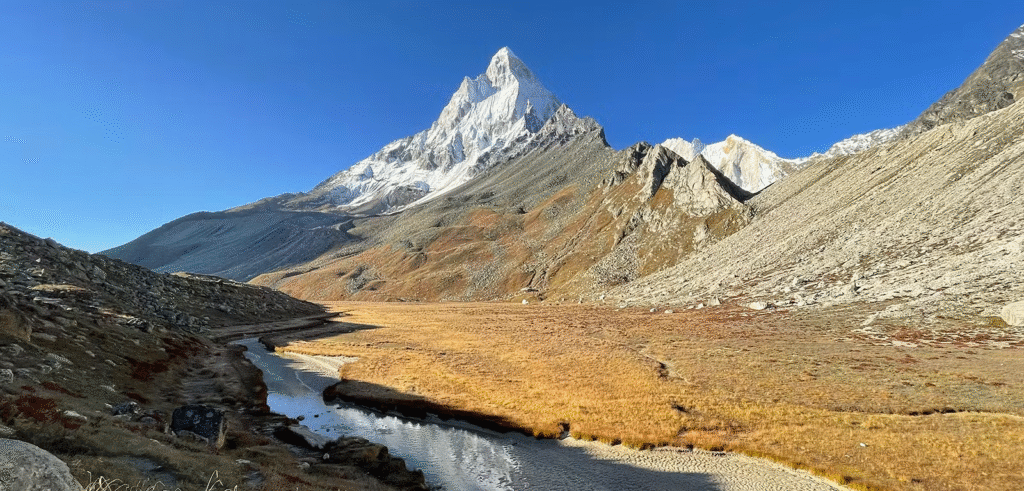
Weather and Temperature Range
In the high altitude the weather changes quickly, so layering is a must
The glacial and high altitude regions, especially at (Tapovan), may have sub-zero temperatures even in summer. There are at least 26 streams between you and the hut, both bodies of water is easily good enough to turn what would be a fun to quest to one which might well kill you. On top of these, this being a glacier (:P) it’ll have its own weather systems; high winds, heavy rainstorm and etc… Turning the glacier from walk in the park into an icy dance with death.
Gaumukh Tapovan Trek Difficulty & Who Can Participate
The Gaumukh Tapovan trek is a moderate to hard difficulty level trek. It is also hard work that must be taken seriously.
Fitness Requirements
It is not an expedition for the fainthearted or first time altitude traveller.
Physical condition: Trekkers should be in good shape with regular exercise. Every-day trekking goes five to seven hours with difficult terrain; longer walks and ascent.
Experience: There is need to have done prior high altitude trek (at least over 12000 ft.) of more than 2-3 days. So, how your body responds to low oxygen levels is important.
Terrain: Trail is clear at first, but later includes several challenging, rocky ascents, cliff sideside ledges and a strenuous scramble across the moraine of the Gangotri Glacier.
Acclimatization and Altitude Sickness
Because of the quick gain in elevation to Tapovan (about 14,640 ft), there is considerable risk for Acute Mountain Sickness (AMS). An itinerary should have sufficient rest days and you need to listen to your body carefully! People with existing heart or respiratory conditions should consult their physician before attempting this hike. Medical evacuation is also difficult and time-consuming due to the remoteness of the hike.
Spiritual and Cultural Significance of Gaumukh Tapovan Trek
Gaumukh Tapovan trek is entwined with the fabric of India’s spiritual story, so this isn’t just about a physical challenge – it’s an ancient pilgrimage.
1.Gaumukh the Maa Ganga as the Holy Snout
Ganga is worshipped by Hindus as Goddess Ganga (Maa Ganga). The source, or Gaumukh, for many pilgrims is the finish line of a holy journey. Bathing yourself in the freezy cold water coming out from near the snout is a ritual carried out by those who believe it to purify and as an act of piety. The entire locality is soaked in mythological tales of King Bhagirath’s extraordinary penance to bring the gushing Ganges down to earth.
2- Meditation ground for Tapovan sages
Tapovan, or ‘forest of austerities,’ has long been a center for spiritual practice. Its intense silence and the magnificent views of Mt. Shivling, as well as the Bhagirathi peaks which inspire awe, has brought to it countless sadhus, rishis and yogis who seek a quiet place away from humanity so they may engage in deep meditation and penance. You may find saffron-clad sadhus, who live here year-round or during summer months, free of the conventions of modern lives.
Local Traditions and Gangotri Culture
The journey starts in Gangotri, a town rich with Hindu tradition. At the center is the Gangotri Temple, dedicated to Goddess Ganga. The interactions with the local Garhwali people and sadhus along the way provide a wonderful sense of a culture that has long lived in the high altitude reality of this land. The modesty and spiritual discipline depicted there provide an added dimension to the adventure.
Wildlife in Gangotri National Park
Hiking inside Gangotri National Park is an adventure through one of India’s most varied and highest-altitude zones.
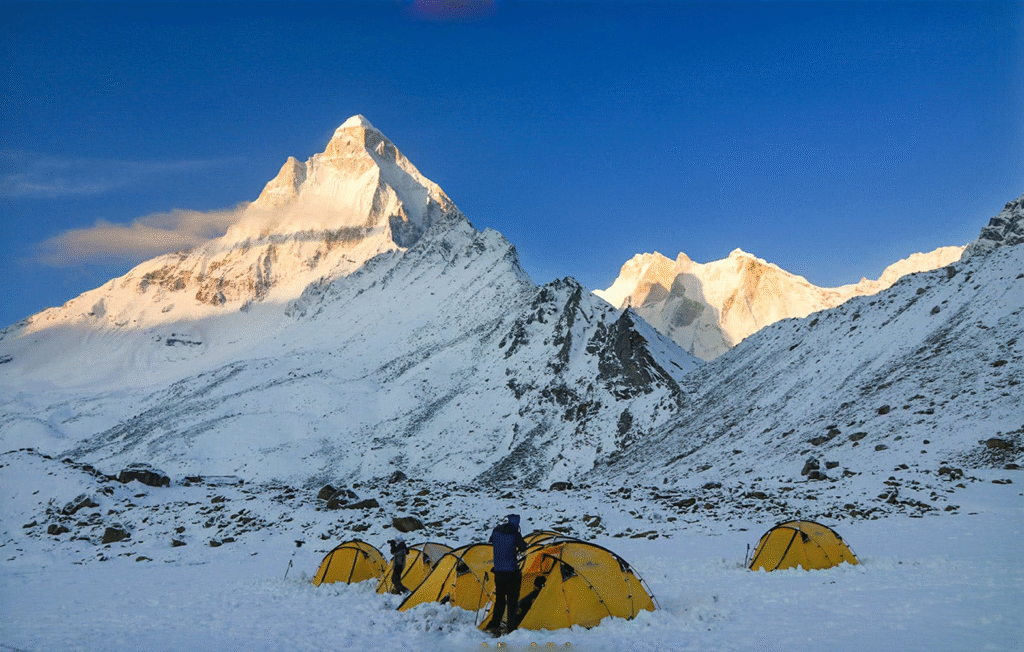
Forest Trails and Alpine Vegetation
The first few kilometers are through dense forests to Chirbasa, which is a small barren land. Here, you will encounter:
Coniferous Trees: Himalayan Blue Pine and Deodar.
Leaf Type: Birch (Bhojpatra) and Rhododendron Alpinum. The Birch tree bark holds historic value for being utilized as a primitive kind of paper.
Alpine Flora As the altitude goes up, tree line gives way to scrub, dwarf rhododendrons and wildflowers of myriad kind and hue when these bloom in summer especially in the grassy expanse situated at Tapovan.
Wildlife Sightings
Common Himalyan birds and animals enliven the forest paths, but in the high-altitude spots one can spot some of the rare and elusive species:
Mammals: Tapovan is the site where one can sight Himalayan Blue Sheep (Bharal) grazing on what appears to be almost vertical rocky cliffs. The fugitive Himalayan Tahr and Siberian Ibex also occupy the upper levels.
The Snow Leopard: Very little is known about the habitat and life of snow leopards as these animals are rarely seen but yes, they do exist and are very here in Markha Valley, finds its shortest way to say that what ever eats mouthful delicacy restaurant, gift also come..!
Birdlife: The park is a bird watcher’s heaven with birds such as the Himalayan Monal (the state bird of Uttarakhand), pheasants and a variety of eagles and vultures, which soar high over the mountain peaks.
Camping and Trek Experience
The camping on Gaumukh Tapovan trek can be as beautiful of an experience as the trek itself, providing one night in wild Himalayas at its best.
Campsites Along the Route
Here are the the main campsites — except maybe numbers 2 and 3 which look to be almost mandatory as they offer two quite different environments at that point:
Chirbasa: A camp between the pines and beside the roaring Bhagirathi river.
Bhojwasa: A larger, more open area, which often feels like a prelude to high Himalaya with views of the Bhagirathi peaks.
Tapovan: The crown jewel. Camping on this vast meadow, usually by a glacial stream, leaves you directly under the towering face of Mt. Shivling *stupendous.
A Night Under the Stars
The night skies on the path to Tapovan are a truly magnificent sight, unspoiled by any sort of light pollution. The Milky Way is frequently visible from one horizon to the other, and the stars are as bright and clear as you will ever see them anywhere outside of a city. The pervasive silence, interrupted only by the sporadic tumult of the river or the far-off groan of ice as it moves, adds to a feeling that you are at one with nature here.
Camp on the Glacier’s Very Edge
Camping at Tapovan means sleeping at the foot of one of the world’s most beautiful mountains, Mt. Shivling, near the base of the colossal Gangotri Glacier. The scale of the landscape and closeness to the raw, frozen power which is a mountain is humbling but exhilarating and profoundly uplifting.
Photography Opportunities
For photographers, amateur and pro alike, the Gaumukh Tapovan trek is a treasure chest of stunning frames with mag cover quality photographs around every corner.

Sunrise and sunset at Mt. Shivling
This is the quest for the photographer’s photograph of the trek. As the sun comes up or goes down, the high-altitude peaks, particularly Mt. Shivling itself, come alive in a brilliant display of light that can turn all of the snow-capped mountain from white to various shades of gold, amber and even pink orange—a phenomenon known as the “Golden Hour”. Tapovan is the best place to witness this fascinating play of light.
Expansive Glacier Landscapes
The unruly, gorgeous landscape of the Gangotri Glacier provides some difficult but fantastic shots. This image does a remarkable job of conveying the scale of the moraine, the textures of rock and ice and the developing flow of the Ganga as it begins to form.
Calmly Meandering Alpine Meadows and Starry Night Skies
The soft green of the Tapovan meadow sharply contrasts with the sharp rock walls surrounding each towering peak itself, a formula for classic composition. Also, with the night sky of scenic clarity, incredible astrophotography can be attempted taking star trails and constellations and milky way across the silhouetted Himalayan peaks.
Check list for Gaumukh Tapovan Trek
Well, a successful and safe trek depends on an intelligent and complete packing list that is well adapted to cold high-altitude weather.
Essential Clothing and Protection
The trick to dealing with dramatic temperature swings in the Himalayas is layering:
Base Layers: Top and bottom that are moisture wicking.
Mid Layers: Fleece tops and warm hiking pants.
Outer Layers: Waterproof and windproof shell jacket and pants.
The Down Jacket: You want a substantial, lightweight down or synthetic insulating jacket for Alpine nights and chilly alpine starts.
Accessories – Warm gloves (waterproof palms and fingers with a polar fleece lining) Wooly hat, neck gator or balaclava Gaiters for snow/slush.
Footwear and Gear
Trekking Boots: Heavy- duty, water resistant upper & supportive high ankles trekking boots with deep aggressive grip for the difficult glacier terrain.
Poles: You will need adjustable trekking poles to provide stability, balance and relieve some of the strain on your knees – on the descent as well as crossing moraine.
Sunblock – High SPF lip sunblock, and category 3 or 4 sunglasses (which must wrap around to avoid snow blindness).
Backpack: A 50-60L pack is pretty standard, with a rainproof cover.
Personal & Safety Items
Water: A reusable water bottle or a hydration bladder. Water purification tablets/drops.
Lights: A powerul headlamp with extra batteries.
Health: Your own personal first aid kid, any prescription medication you use, and plenty of energy foods such as dry fruits/ energy bars. Diamox (Acetazolamide) for AMS, as recommended by doctor.
Paperwork: Photo ID copy, Copy of Gangotri National Park permit, Travel insurance details.
Safety Tips & AMS Awareness
First of all, safety in a high altitude trek such as Gaumukh Tapovan is of utmost importance.
Importance of Acclimatization
Acute Mountain Sickness (AMS) is the most significant risk. The best defense is an well-calibrated itinerary.
Go Slow: Never attempt to make the trek go faster. It’s the mantra of “walk high, sleep low.”
HYDRATE, HYDRATE, HYDRATE Drink 4-5 liters of water per day. Dehydration exacerbates AMS symptoms. Refain from alcohol and smoking, because they inhibit the body’s adaptability to altitude.
Track Symptoms: Watch for the first symptoms of AMS too, which are headache, nausea, loss of appetite and dizziness. Never ascend if symptoms worsen. Nothing will cure severe AMS but descent.

Glacier Walking Precautions
At the Gangotri Glacier, all attention and safety instructions are required:
Leader of the pack: Only cross if you are under the direct watch of a certified and experienced local trek leader or guide that is in tune with glacial conditions at that time.
Mind Your Step: The moraine is unstable. Be careful of falling rocks and slick ice patches.
Go One-on-One: Never start crossing a glacier alone and never leave the group.
Choosing Certified Trek Leaders
Because of the undeveloped area, tough terrains and park permits required, always consider trekking Gaumukh Tapovan with a professional, certified trekking company experienced in these parts carrying emergency oxygen support, fully equipped first-aid kit along with proper evacuation plans.
Why Choose Gaumukh Tapovan Trek
The Himalayas boast hundres of routes, but none rival Source of the Ganga and Beyond for sheer spectacle.
Perfect Blend: It may be the most famous itinerary that seamlessly combines deep spirituality with aggressive, pristine Himalayan adventure. It’s the everything to a pilgrim: soul and test for leg muscles.
A Holy Beginning: It is a special privilege to visit the headwaters of one of Earth’s most major rivers, a landmark that holds deep cultural and ecological meaning.
Close Encounter with Giants : The continuous, majestic company of the Bhagirathi peaks and the towering, lordly Shivling’s; they are some of the most awesome Himalayas vistas that will not erase your memories even for decades to come down in Indian Himalayas.
The Gaumukh Tapovan trek may be a pilgrimage—a trip that challenges you, nourishes your soul and brings the change in you with the purity and grandure of mountains at source of life. Tie up your boots, prepare your heart and set out on the timeless path that leads to the soul of sacred Garhwal Himalayas.
If you loved reading about this trek you might also like Kedarkantha trek. Contact us, to join in our trekking journey.


